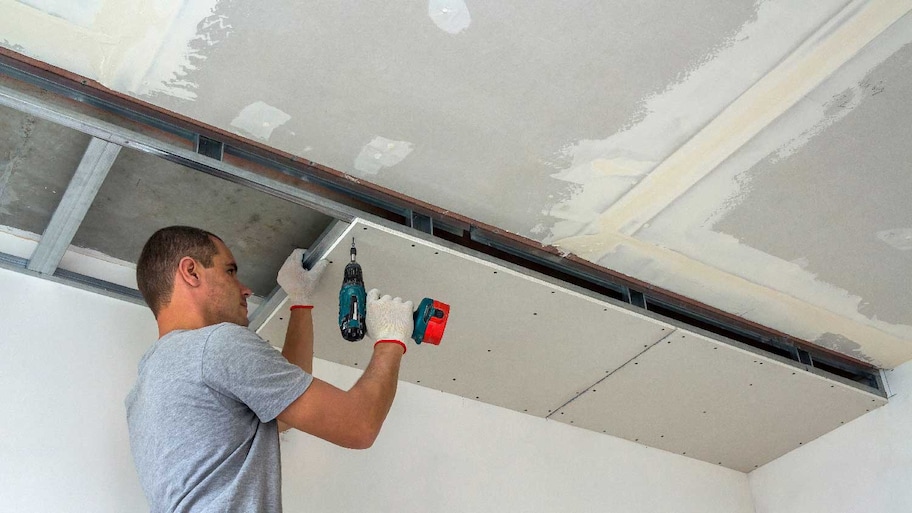How Much Does a Drop Ceiling Cost? [2024 Data]
Normal range: $1,081 - $3,294
Installing a drop ceiling costs $2,176 on average, but can range between $389 and $6,800 depending on tile material, add-ons, and insulation.


The cost to install a drop ceiling typically ranges from $1,081 to $3,294, and the average price to install one of these aesthetically pleasing, highly functional features is around $2,176. When designing a high-end look that changes the vibe of a space, note that costs for lighting, tiles, and rail covers can raise your project budget. In this guide, we’ll explain the different factors that influence your drop ceiling cost to help you plan out your project budget.
- Average
- $2,176
- Low end
- $389
- high end
- $6,800
How Much Does It Cost to Install a Drop Ceiling by Square Foot?
Your drop ceiling cost per square foot is the easiest way to make a guestimate about your final bill. On average, expect to pay between $9 and $13 per square foot for standard installation and materials.
However, drop ceiling installation costs can range anywhere from $5 to $28 per square foot, and are highly dependent on the cost of the drop ceiling tiles you choose. Add-ons such as lighting, specialized grid rails, or insulation boards behind your tiles push the cost to the higher end.
Drop Ceiling Installation Cost Factors
| Cost Factor | Cost |
|---|---|
| Ceiling Removal | $2–$4 per square foot |
| Drop-Out Panels | $100 per panel |
| Edge Details | $4–$10 per square foot |
| Light Panels | $20–$50 per panel |
| Moving Vents | $400–$750 per vent |
| Wiring | $3–$5 per square foot |
When you hire a professional ceiling installer, the cost of drop ceiling installation varies greatly depending on a wide variety of factors. Let's break down each factor.
Size of Room
In most cases, the larger the square footage of the ceiling, the higher the cost. However, keep other size factors in mind. Particularly high ceilings that are difficult to reach can raise the price. Oddly shaped rooms that require specialized panels and custom designs can also bump up the price tag. And lastly, some contractors will discount per-square-foot rates for large rooms or multiple rooms you want done at the same time.
Materials
The cost of drop ceiling materials breaks up primarily between the grid rails and the drop ceiling tile costs. Decorative rail covers and insulation will add to the base price of these two categories. Here are some common price ranges to keep in mind:
Cost of drop ceiling tiles: Anywhere from $1–$70 per square foot (more on this below)
Suspended grid rails: $1.50–$2.25 per square foot
Insulation tile backing: An additional $2 per square foot
Decorative rail covers: An additional $1 per square foot
Miscellaneous installation accessories (wires, clips, etc.): $0.75 – $1.15 each
Labor

Materials aside, ceiling specialists will charge between $2 and $5 per square foot, or an average of $3.50 per square foot. You may also receive an hourly rate between $30 and $85 per hour, with rates falling on the higher end of the spectrum for acoustic ceilings and rooms with special features such as lights, fans, switches, and decorative options.
Remember, your room size and ceiling height can increase labor time, which will, of course, drive up your total project costs.
Ceiling Removal
If you need your current ceiling removed or prepped, factor in costs for popcorn ceiling removal ($900 to $2,840) or the costs to repair a ceiling ($335 to $1,125) if you’re leaving a portion of your existing ceiling. Removing a drywall ceiling costs between $2 and $4 per square foot, while removing an old drop ceiling will cost from $2 to $7, which includes disassembling the rail system.
Permits
You may need a permit if your town or city has rules about minimum ceiling clearance. If a permit is required, the average cost for a small project like a drop ceiling is around $150. The price of a building permit ranges quite a bit for construction projects on average, so either contact your local building department or ask your contractor how much your permits will cost.
If you hire a pro for this job, they’ll typically include the cost of a permit in their original quote and take care of the paperwork for you.
Wiring
If your new ceiling placement necessitates moving or dropping down ceiling lights, you may need to factor in the $50 to $100 hourly rate charged by electricians.
Moving Vents
Your current HVAC system may feature heating and cooling vents that tuck behind your drop ceiling tiles. So, keep in mind that you may need to factor in the $50 to $150 hourly rate for HVAC tech services. If you need to make substantial changes to the ductwork, you could pay between $400 and $750 per vent you need to be relocated.
Light Panels
You can swap out any of your drop ceiling tiles with light panels of the exact same size, making it easy to brighten up your room. You can expect to pay between $20 and $50 per light panel, which includes the materials and labor. You may also have to pay to have an electrician route wiring to the area, which could increase this price.
Drop-Out Panels
Buildings that house the sprinkler system on the ceiling may require drop-out tiles. These tiles melt away when they detect high heat, revealing the sprinkler and allowing the system to activate. Each 2-by-4-foot tile will cost around $100. Many residences don’t require sprinkler systems by law, but multi-family homes and businesses often do.
Edge Details
Opt for tiles with a bit of style by choosing designs with decorative edges exposed to the room. They will cost between $2 and $4 more per tile than your standard square, but they provide a cleaner, more modern appearance. Edge-detailed tiles may even hide the grid itself, creating a more cohesive look.
Cost to Install a Drop Ceiling by Tile Material
| Tile Material | Cost Per Square Foot |
|---|---|
| Black Acoustic | $2–$7 |
| Fiberboard | $1–$7 |
| Metal | $12–$20 |
| Plastic | $5–$9 |
| Wood | $10–$70 |

Depending on how much you want to save or spend, you have a list of different tile choices.
Fiberboard Tile
This material is one of the lowest-cost options, coming in at $2 to $7 per square foot. In fact, standard mineral fiberboard is even more affordable at $1 to $4 per square foot. While fiberboard is a good value, you should keep in mind that it's not a good fit for a high-moisture area.
Plastic Tile
This material is a top pick for cutting costs on a drop ceiling installation while still maintaining a clean look, coming in at $5 to $9 per square foot. While many may not find it quite as elegant as the high-end options, plastic is highly functional without breaking the bank.
Black Acoustic Ceiling Tile
Good for a middle-range budget, this material works if you're building a studio or entertainment center. Black acoustic ceiling tiles cost about $2 to $7 per square foot. Of course, you'll want to make sure you're getting the most durable option for your money because black ceiling tiles can be made of fiberglass, vinyl, foam, and much more.
Metal Tile
This sturdy material is considered the most attractive option for a drop ceiling. It's also extremely durable and water resistant. As such, metal comes with a higher price tag ranging widely from $12 to $20 per square foot. Determining your budget early can help you choose the kind of metal that fits well within your project.
Wood Tile
One of the priciest options among ceiling panels, wood brings texture, sophistication, and warmth to a space. It also comes in around $10 to $70 per square foot. However, that large range means that you may be able to find a type of wood that meets both your aesthetic needs and your budget.
Tips to Save on Drop Ceiling Costs
Drop ceilings can be expensive, but there are ways to make their installation more affordable.
Choose the Right Material
High-quality materials like wood and metal are more water resistant than fiberboard, and these materials add value to your home. While plastic is more durable and affordable than fiberglass, both tend to be less desirable to homebuyers, and installing them won’t necessarily increase your home value. To save money on installation, choosing plastic, fiberglass, or fiberboard is cheaper in the short term, but can be more costly in the long term when considering their shorter life spans.
Plan Your Layout
Drawing an accurate outline to plan the layout of your tiles will allow you to buy the right amount of material and position your tiles optimally. This step will help you avoid overbuying tiles and visualize an efficient and attractive layout. The way your ceiling looks is an important aspect of your project’s success, as a home improvement project that you decide to redo in a couple of years because you’re not happy with it won’t save you much money.
Unpack Your Panels Early
Panels need time to acclimate to your interior temperature so that any expansion and contraction happen before they are installed for a good fit. Panels should be stored between 60 and 80 degrees Fahrenheit, and you should ensure your local humidity is below 70%. Getting your panels ready at least 24 hours ahead of time will allow you to bring them to an optimal temperature and moisture level before you install them. This step can save you time and money because you will not need to go back and make as many adjustments.
DIY vs. Hiring a Pro
It’s possible to DIY your drop ceiling, but the process is deceptively difficult. Leveling the grid alone can prove to be too challenging even for experienced DIYers, especially since you’ll have to do most of the work from the top of a ladder. If you do decide to do the work yourself, you could save an average of around $1,200 on your project, or around $3.50 per square foot.
Given the complexity of the work and the risk of the finishing project being unlevel and unsightly, most homeowners prefer to leave this work to a professional. When you call a local ceiling repair company or ceiling installer to get the job done, you can rest assured that the finished product will look professional, neat, and clean. You’ll also avoid the added cost of attempting the work yourself, only to hire a professional to fix any mistakes or redo the entire ceiling.
Instead, you can save some money by following the tips below:
Purchase materials yourself to avoid contractor upcharges
Carry out the demolition of your existing ceiling yourself
Limit how much new wiring you have run through the ceiling
Avoid moving ceiling vents, if possible
How Angi Gets Its Cost Data
Home is the most important place on earth, which is why Angi has helped more than 150 million homeowners transform their houses into homes they adore. To help homeowners with their next project, Angi provides readers with the most accurate cost data and upholds strict editorial standards. We survey real Angi customers about their project costs to develop the pricing data you see, so you can make the best decisions for you and your home. We pair this data with research from reputable sources, including the U.S. Bureau of Labor Statistics, academic journals, market studies, and interviews with industry experts—all to ensure our prices reflect real-world projects.
Want to help us improve our cost data? Send us a recent project quote to [email protected]. Quotes and personal information will not be shared publicly.
Dan Simms contributed to this article.
Frequently Asked Questions
Drop ceilings and suspended ceilings are different names for the same thing: a ceiling made from a rail system and panels that hang below where a standard ceiling would sit. Like many types of ceilings and home trends, terminology changes depending on who's describing it and where you live. You may also hear terms such as grid ceiling, drop-in ceiling, dropped ceiling, or T-bar ceiling.
Installing drywall will cost between $1.50 and $3 per square foot for materials, labor, and finishing, which is quite a bit lower than the average of $9 to $13 per square foot for a drop-tile ceiling. So, while drop ceilings allow more design flexibility, provide easy access to utility lines above them, and are often much easier and less expensive to repair, they do cost more upfront. You can minimize your drop ceiling cost by opting for more affordable fiberboard panels, although some homeowners don’t like the look of this material.
Stylish drop tiles, such as wood or metal, could add value to your home if the drop ceiling hides imperfections on an old surface. However, traditional fiberboard and plastic drop ceilings can have the opposite effect, especially if new prospective buyers do not like that aesthetic. Savvy buyers may also know that drop ceilings are a go-to ceiling option in areas where leaks are an issue, given the easy access to the area above the ceiling and the ease of replacing a single tile. This could dissuade a buyer from purchasing your home.
It’s possible to paint certain drop ceiling tiles, including those made of plastic, metal, and wood. Painting fiberboard ceiling tiles is technically possible, but the results rarely look appealing, so it’s best to replace them with new tiles, especially given how affordable they are. If you do paint your drop ceiling tiles, it’s a good idea to use a paint sprayer and a rapidly-drying paint to avoid drips. Latex paint is often a good choice, especially if you thin it and apply it using a sprayer.
